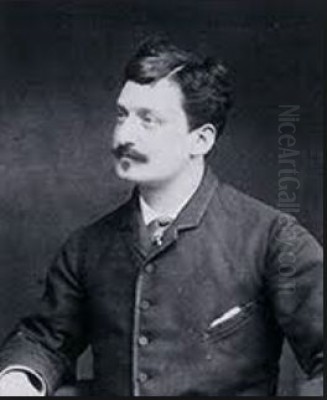
Cesare Agostino Detti stands as a significant figure in late 19th-century European art, an Italian painter who achieved considerable fame not primarily in his homeland, but in the bustling art capital of Paris. Often mistakenly referred to as Cesare Auguste Detti, his correct name is Cesare Agostino Detti. Born in Spoleto, Italy, on December 28, 1847, and passing away in Rome on May 19, 1914, Detti carved a niche for himself with his exquisitely detailed and romantically charged historical genre scenes, particularly those evoking the elegance and charm of the 17th and 18th centuries. His work, popular among collectors on both sides of the Atlantic, offers a fascinating window into the tastes and artistic currents of his time.
Early Life and Artistic Formation in Italy
Cesare Agostino Detti's journey into the world of art began in an environment conducive to creative pursuits. His father, Davide Detti, was an engineer by profession but also a passionate amateur painter and reportedly a professor at the prestigious Accademia di San Luca in Rome. Recognizing his son's burgeoning talent and interest, Davide encouraged Cesare's artistic inclinations from a young age. The family resided in Spoleto, a historically rich town in Umbria, which may have provided early visual inspiration for the young artist.
A pivotal moment occurred when Detti was around fifteen years old. He was introduced to Francesco Coghetti (1802–1875), a respected Roman artist known for his frescoes and paintings, often in a style that bridged late Neoclassicism and early Romanticism. Coghetti, recognizing the young Detti's potential, advised him to pursue formal art training. Following this counsel, and likely with his father's support and connections, Detti enrolled at the Accademia di San Luca in Rome in 1861.
The Accademia di San Luca was, and remains, one of Italy's most important art institutions. Here, Detti received a rigorous academic grounding in drawing, composition, and painting techniques. He studied at the Accademia until 1866, immersing himself in the artistic environment of Rome. During these formative years, he would have studied the works of Old Masters and engaged with the prevailing academic traditions, laying the technical foundation for his later detailed style.
The Influence of Fortuny and the Path to Paris
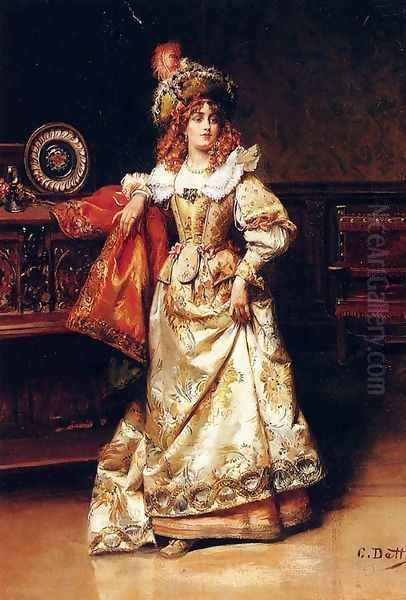
While studying in Rome, Detti encountered artists who would significantly shape his artistic direction. One of the most crucial influences was the Catalan-Spanish painter Mariano Fortuny y Marsal (1838–1874), often referred to simply as Fortuny. Fortuny, though Spanish, spent considerable time in Rome and became a leading figure in an international circle of artists. He was renowned for his dazzling technique, vibrant color palette, and meticulously detailed genre scenes, often with historical or Orientalist themes.
Fortuny's style, sometimes called "Fortunismo," captivated many younger artists, including Detti. Its emphasis on brilliant light, rich textures, precise rendering of details (especially fabrics and objects), and lively brushwork offered an alternative to the stricter forms of academic painting. Some sources connect Detti, through Fortuny's influence, to the spirit of the Italian "Macchiaioli" movement, primarily in its shared interest in realism and capturing light, although Detti's focus remained more on historical narrative and elaborate detail than the characteristic 'macchia' (patch or spot) technique of core Macchiaioli painters like Giovanni Fattori or Telemaco Signorini. Detti adopted Fortuny's penchant for historical settings and detailed costume, which became hallmarks of his own work.
Perhaps inspired by Fortuny's international success and the allure of the Parisian art market, Detti began looking beyond Italy. Around 1876, a significant opportunity arose when he established contact with Adolphe Goupil (1806–1893), one of the most influential art dealers in Paris. Goupil & Cie was a powerhouse in the 19th-century art world, known for dealing in works by prominent academic and genre painters and disseminating them through high-quality reproductions (engravings and photogravures). Representing artists like Jean-Léon Gérôme and William-Adolphe Bouguereau, Goupil had a keen eye for painters whose work appealed to the tastes of the wealthy bourgeoisie in Europe and America.
The connection with Goupil proved decisive. Detti moved to Paris around this time, recognizing it as the epicenter of the international art market and the place where reputations were made. Goupil began to handle Detti's work, providing him access to a network of collectors and exhibition venues. Through Goupil, Detti also likely interacted with other artists represented by the gallery, such as the fellow Italian expatriate Giuseppe De Nittis (1846-1884) and the Spanish painter Ignacio de Leon y Escosura (1834–1901), who also specialized in historical genre scenes.
Success in the Parisian Art World
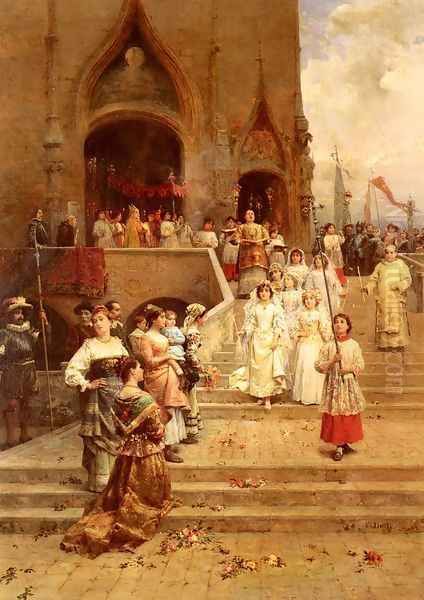
Settling in Paris marked the beginning of the most successful phase of Detti's career. He made his debut at the prestigious Paris Salon in 1876. The Salon, organized annually (or biennially) by the Académie des Beaux-Arts, was the most important art exhibition in the world at the time. Acceptance into the Salon was crucial for an artist's reputation and commercial success. Detti continued to exhibit regularly at the Salon in subsequent years, including 1877, 1889, and 1900, solidifying his presence in the French art scene.
His paintings, with their charming subjects, historical accuracy in costume and setting, and brilliant execution, found favor with critics and collectors. He specialized in what became known as the "Troubadour style" or "style anecdotique," though he applied its romantic sensibility primarily to the 17th and 18th centuries rather than the medieval period typically associated with the term's origin. His works often depicted scenes of courtship, aristocratic leisure, musicians, cavaliers, and elegant ladies in opulent interiors or picturesque gardens, rendered with meticulous attention to detail and a vibrant, jewel-like palette reminiscent of Fortuny.
Detti's international reputation grew. He participated in the Italian Exhibition held in London in 1888, showcasing his work to a British audience. A significant accolade came at the Exposition Universelle (World's Fair) held in Paris in 1900, where he was awarded a silver medal. These international exhibitions were major cultural events, and success at them brought widespread recognition. Detti's paintings became sought after by collectors in France, Britain, and particularly the United States, facilitated by dealers like Goupil.
Artistic Style and Thematic Focus
Cesare Agostino Detti's artistic identity is firmly rooted in historical genre painting. His primary inspiration came from the 17th and 18th centuries, periods associated with Baroque grandeur and Rococo elegance. He was particularly drawn to the visual splendor of these eras – the elaborate costumes, ornate interiors, and refined social customs. His paintings are often characterized by a narrative quality, telling small stories or capturing moments of everyday life, albeit idealized and set in the past.
His style reflects a blend of influences. The academic training received at the Accademia di San Luca provided him with a strong command of drawing and composition. The influence of Mariano Fortuny y Marsal is evident in his brilliant color, attention to textural detail (silks, satins, metals), and lively, almost sparkling, brushwork in certain passages. There's also an affinity with the spirit of 18th-century French Rococo painters like Antoine Watteau and Jean-Honoré Fragonard in his depictions of fêtes galantes, courtship, and idyllic pastoral scenes, though rendered with a 19th-century sense of realism and detail.
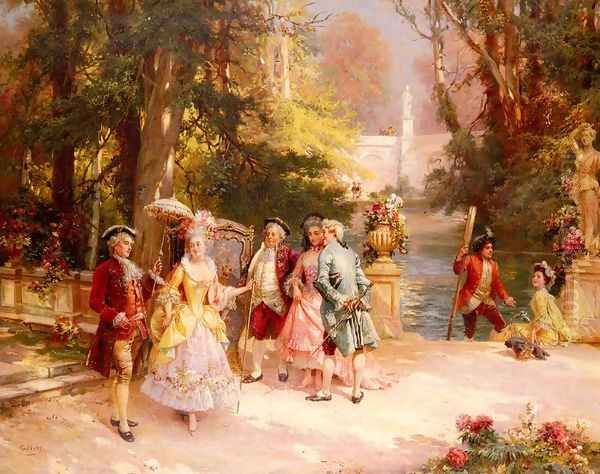
Detti excelled at depicting fabrics. The silks, velvets, lace, and brocades of historical costumes are rendered with palpable texture and luminosity. His figures, often poised and elegant, populate meticulously researched settings – castle gardens, opulent salons, artist studios, or village squares. While the subjects are historical, the sentiment is often romantic or nostalgic, appealing to a contemporary desire for escapism and idealized visions of the past. His work stands somewhat apart from the major avant-garde movements of his time, like Impressionism, focusing instead on technical polish, historical narrative, and decorative appeal, much like other successful Salon painters such as Ernest Meissonier, who also specialized in small-scale historical scenes.
Life in France and the Marlotte Connection
Detti fully integrated into French life. In 1880, he married Juliette-Emilie Filieuse in Paris. The couple had three children. Subsequently, they moved from the heart of Paris to Bourron-Marlotte, a village on the edge of the Forest of Fontainebleau, southeast of Paris. This area was famous for its association with the Barbizon School of landscape painters.
By moving to Bourron-Marlotte, Detti joined a community of artists. Sources mention his joining the "Groupe de la Marine" or Marlotte School around 1880. While primarily known for his historical genre scenes, his time in this artist colony, frequented by landscape painters inspired by the natural beauty of the Fontainebleau forest (like Jean-Baptiste-Camille Corot, Jean-François Millet, Théodore Rousseau, and Charles-François Daubigny before him), may have encouraged him to incorporate more landscape elements into his backgrounds or perhaps even explore landscape painting more directly, although his fame rests on his costumed figure paintings. Life in Bourron-Marlotte likely provided a tranquil setting for his family and his meticulous studio work.
He continued to travel later in life, with sources mentioning trips to Latin America and the United States, likely connected to the exhibition and sale of his works to international clientele. These journeys would have broadened his horizons and potentially introduced his work to new audiences directly.
Representative Works
Throughout his prolific career, Detti produced a considerable body of work, estimated at around 77 paintings, many of which survive today in private and public collections. Some of his representative titles capture the essence of his thematic interests and style:
_Waiting for her Escort_: This title suggests a typical Detti subject – a beautifully dressed lady, perhaps in an interior or garden setting, anticipating an event or arrival, allowing for detailed costume depiction and a hint of narrative.
_The Confirmation_: Likely depicting a religious ceremony, this subject would allow Detti to portray figures in specific attire within a potentially historical architectural setting, blending genre with a touch of solemnity.
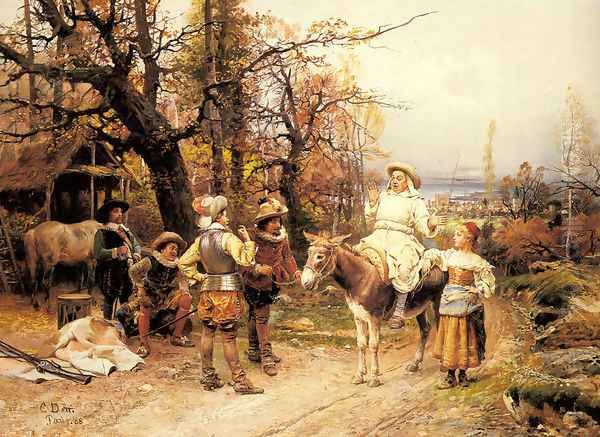
_In the Garden of the Castle_ (or _The Castle Garden_): This title points to his frequent use of picturesque outdoor settings, often featuring elegant figures enjoying leisure activities amidst manicured gardens and historical architecture.
_A Halt Along the Way_: Suggests a scene involving travelers, perhaps in 17th or 18th-century attire, resting during a journey, offering opportunities for depicting horses, carriages, and varied character types.
_Louis XV of France in the Throne_: A more specific historical subject, focusing on a known figure and requiring accurate portrayal of courtly settings and royal regalia.
_The Procession_: This could depict either a religious or secular procession, allowing for a multi-figure composition with diverse costumes and a sense of movement or occasion.
_Summer Idyll_: Evokes the pastoral and romantic side of Detti's work, likely featuring figures in an idealized landscape, enjoying simple pleasures in elegant historical dress.
These titles reflect Detti's consistent focus on historical elegance, romantic encounters, and moments of aristocratic or bourgeois life from past centuries, all rendered with his characteristic technical skill and vibrant color.
Final Years and Legacy
The outbreak of World War I in 1914 cast a shadow over Detti's later life. Despite having lived and worked in France for nearly four decades and being married to a French woman, Detti had apparently not secured French citizenship. As an Italian citizen, he found himself designated an enemy alien in France after Italy initially remained neutral before eventually joining the Allies. Some accounts also mention the death of his son around this time, prompting a return to Italy.
Forced to leave his home and career in France, Detti returned to Italy, settling in Rome. However, his time back in his native country was brief. He passed away in Rome on May 19, 1914, at the age of 66, shortly after his return and as Europe descended into conflict.
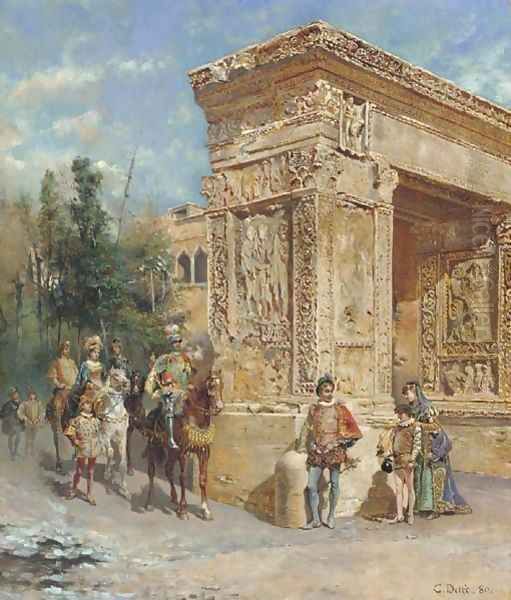
Cesare Agostino Detti left behind a legacy as a highly skilled and successful painter of historical genre scenes. He was one of many talented European artists, including fellow Italians like Giovanni Boldini and Antonio Mancini who found fame and fortune in Paris during the Belle Époque. While not an innovator in the mold of the Impressionists or Post-Impressionists, Detti masterfully catered to the prevailing tastes of his time for beautifully crafted, historically evocative, and charmingly narrative paintings. His work celebrated elegance, romance, and the visual richness of the past, executed with a technical brilliance inherited from his academic training and refined through the influence of masters like Fortuny. Today, his paintings remain popular with collectors and are appreciated for their decorative qualities, historical detail, and enduring nostalgic appeal, securing his place as a distinctive voice in late 19th-century European art.